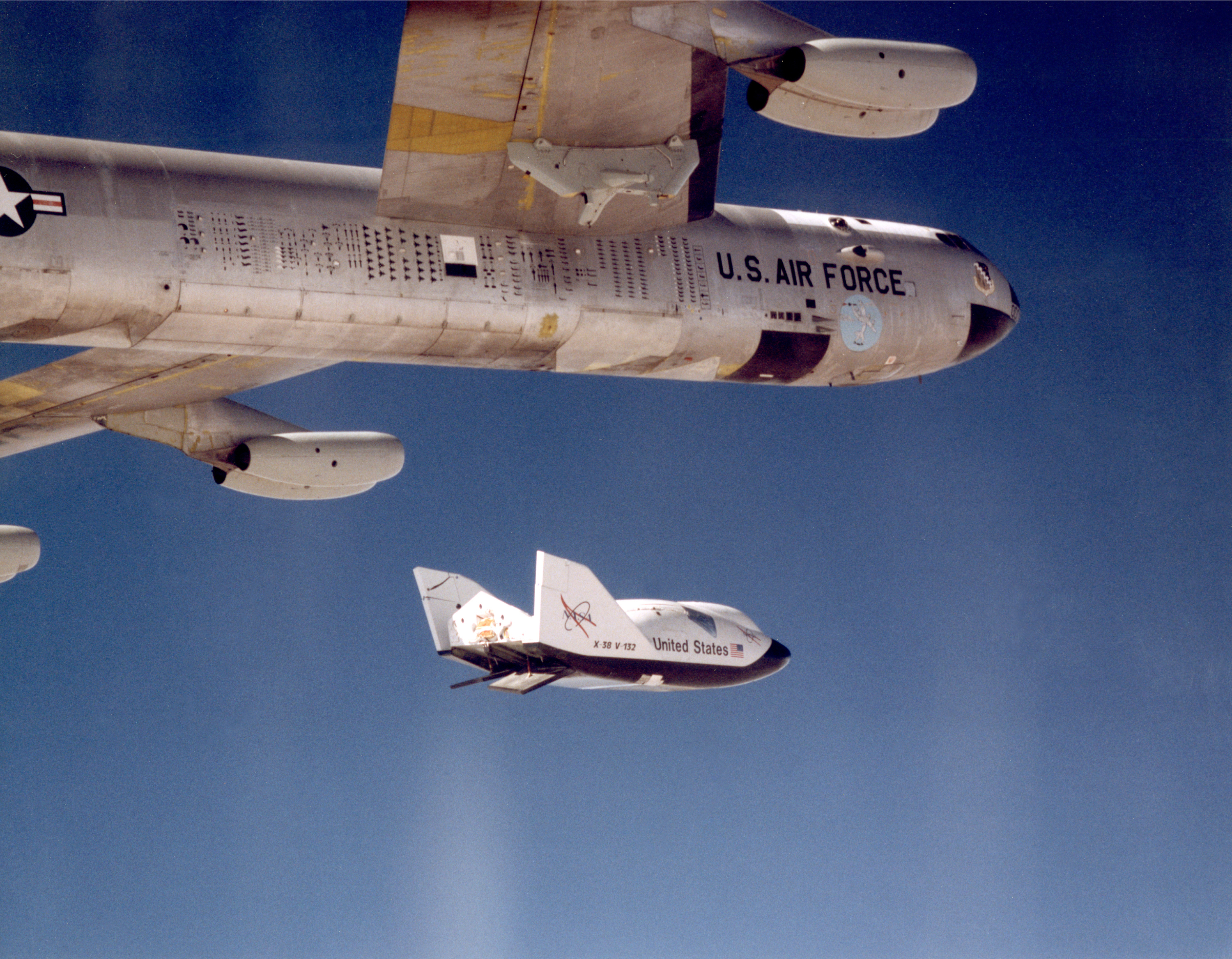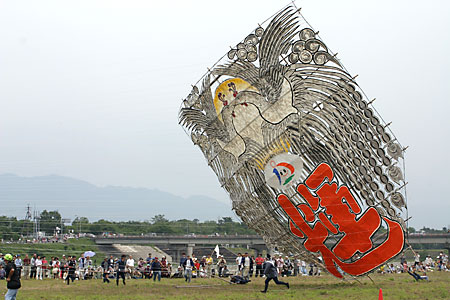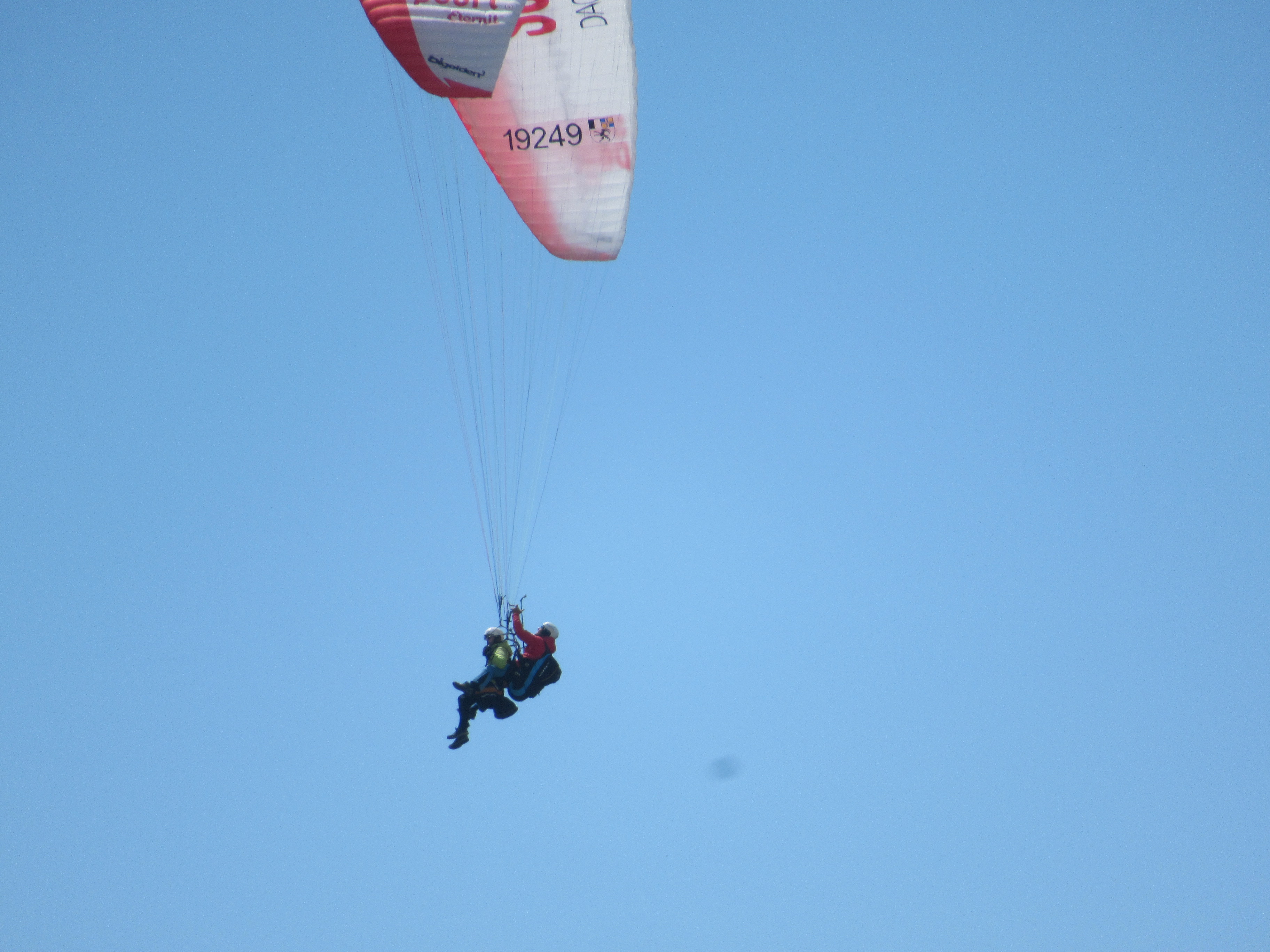|
Parafoil
A parafoil is a nonrigid (textile) airfoil with an aerodynamic cell structure which is inflated by the wind. Ram-air inflation forces the parafoil into a classic wing cross-section. Parafoils are most commonly constructed out of ripstop nylon. The device was developed in 1964 by Domina Jalbert (1904–1991). Jalbert had a history of designing kites and was involved in the development of hybrid balloon-kite aerial platforms for carrying scientific instruments. He envisaged the parafoil would be used to suspend an aerial platform or for the recovery of space equipment. A patent was granted in 1966. Deployment shock prevented the parafoil's immediate acceptance as a parachute. It was not until the addition of a drag canopy on the riser lines (known as a "slider") which slowed their spread that the parafoil became a suitable parachute. Compared to a simple round canopy, a parafoil parachute has greater steerability, will glide further and allows greater control of the rate of desce ... [...More Info...] [...Related Items...] OR: [Wikipedia] [Google] [Baidu] |
Powered Parachute
A powered parachute, often abbreviated PPC, and also called a motorized parachute or paraplane, is a type of aircraft that consists of a parafoil with a motor and wheels. The FAA defines a powered parachute as ''a powered aircraft a flexible or semi-rigid wing connected to a fuselage so that the wing is not in position for flight until the aircraft is in motion. The fuselage of a powered parachute contains the aircraft engine, a seat for each occupant and is attached to the aircraft's landing gear.'' While in flight, and due to the design of the parafoil, PPCs effectively travel at a fixed airspeed, typically about 25–35 mph (40–60 km/h). PPCs operate safely at heights ranging from a few feet off the ground (e.g., skimming, fly-bys) to altitudes as high as 10,000+ ft (3+ km), but typical operating heights are between 500 and 1500 feet (150–500 meters) above ground level (AGL). Equipped with a 5-15 gallon fuel tank (depending on the engine and weight limitations), PPCs c ... [...More Info...] [...Related Items...] OR: [Wikipedia] [Google] [Baidu] |
Domina Jalbert
Domina Cleophas Jalbert (1904–1991) invented the ram-air inflated flexible wing, often called the "Jalbert parafoil". Personal life Domina Jalbert was born in Saint-Jean-de-Matha, Quebec, Canada; his father was Onesime Jalbert (1856–1938) and his mother was Celestine Gouger (1861–1939). He was one of 17 children. Early in his life he moved to Woonsocket, Rhode Island, where he lived and worked for many years before moving to Boca Raton, Florida, in his older years. While living in Woonsocket, Jalbert graduated from Woonsocket High School, and later worked as a track coach and administrator for Mount St. Charles Academy. Jalbert received a U.S. pilots' license in 1927. In the 1930s he was active in kiting, using large kites for advertising purposes. He was hired to help protect the coastline of the western United States during war with the design and making of barrage balloons; he worked for the United States Rubber Company in Naugatuck, Connecticut, USA. Jalbert la ... [...More Info...] [...Related Items...] OR: [Wikipedia] [Google] [Baidu] |
X-38 Ship -2 Landing On Lakebed EC99-45080-101-EDIT1
The X-38 was an experimental re-entry vehicle designed by NASA to research a possible emergency crew return vehicle (CRV) for the International Space Station (ISS). The 1995–2002 program also developed concepts for a crew return vehicle design that could be modified for other uses, such as a possible joint U.S. and international human spacecraft that could be launched on the French Ariane 5 booster. The program would eventually develop a total of three test prototype flight demonstrators for the proposed Crew Return Vehicle, each having incremental improvements on its predecessor. All three were wingless lifting body vehicles used in drop tests. The X-38 program was canceled in 2002 due to budget cuts. History The maximum crew size for the ISS is dependent on crew rescue capacity. Since it is imperative that the crew members be able to return to Earth in case of an unexpected emergency, a Crew Return Vehicle able to hold up to seven crew members was initially planned by the ... [...More Info...] [...Related Items...] OR: [Wikipedia] [Google] [Baidu] |
Kite Types
Kites are tethered flying objects which fly by using aerodynamic lift, requiring wind (or towing) for generation of airflow over the lifting surfaces. Various types of kites exist, depending on features such as material, shape, use, or operating skills required. Kites may fly in air, water, or other fluids such as gas and other liquid gaining lift through deflection of the supporting medium. Variations in design of tethering systems and lifting surfaces are regularly introduced, with lifting surfaces varying in stiffness from limp sheet material to fully solid material. Manufacture Kites may be built by the flier or by a dedicated kite manufacturer, which may be a member of the Kite Trade Association International (KTAI), which also includes kite retailers. Materials Kites have been made from the following materials: *Plastic – for example, a Styrofoam-only kite *Organic materials – such as plant leaves and grass *Paper *Textiles such as rip-stop nylon, nylon, or Dacron ... [...More Info...] [...Related Items...] OR: [Wikipedia] [Google] [Baidu] |
Foil Kite
Foil kites are soft kites based on the design of the parafoil. They consist of a number of cells running fore to aft, some or all of which are open at the front to allow air to inflate the kite so it takes on an aerofoil section. Due to the amount of power that these kites can generate, they can be used for a variety of different activities including kitesurfing, kite landboarding, snowkiting, kite buggying, kite-energy systems or airborne wind energy, and recreational kiting. Foil kites are flown with various line set-ups that includes 2-, 3- and 4-line systems; 2-line systems consisting of rings, wrist bands or bar compared to depowerable 4-line systems using a bar or handles. (See also: kite control systems) In order to make them suitable for use on water some foils have limited air inlets in the centre of the leading edge, with valves to keep the air in and (hopefully) the water out. Internal holes in the cell sides allow the whole kite to inflate. These kites are naturally s ... [...More Info...] [...Related Items...] OR: [Wikipedia] [Google] [Baidu] |
Kite Flying
A kite is a tethered heavier-than-air or lighter-than-air craft with wing surfaces that react against the air to create lift and drag forces. A kite consists of wings, tethers and anchors. Kites often have a bridle and tail to guide the face of the kite so the wind can lift it. Some kite designs don’t need a bridle; box kites can have a single attachment point. A kite may have fixed or moving anchors that can balance the kite. The name is derived from kite, the hovering bird of prey. The lift that sustains the kite in flight is generated when air moves around the kite's surface, producing low pressure above and high pressure below the wings. The interaction with the wind also generates horizontal drag along the direction of the wind. The resultant force vector from the lift and drag force components is opposed by the tension of one or more of the lines or tethers to which the kite is attached. The anchor point of the kite line may be static or moving (e.g., the towing of a ... [...More Info...] [...Related Items...] OR: [Wikipedia] [Google] [Baidu] |
Slider (parachuting)
A slider is a small rectangular piece of fabric with a grommet near each corner used to control the deployment of a "ram-air" parachute. Also called a "reefing device." A ram-air parachute has a tendency to open very rapidly. At high velocities, the opening shock from a rapid deployment can cause damage to the canopy or injury to the jumper. The slider was developed as a way of mitigating this. During deployment, the slider slides down from the canopy to the risers. Air resistance slows its descent. The slider holds the lines together, which slows the parachute inflation. The slider also deflects some of the rising air column away from the center of the canopy as it inflates. This also helps moderate the speed of opening. This invention solved the rapid deployment problem with ram-air designs. Sliders also reduce the chance of the lines twisting to cause a malfunction. In BASE jumping a rapid canopy deployment is desirable. The slider may be constructed of mesh, packed so that th ... [...More Info...] [...Related Items...] OR: [Wikipedia] [Google] [Baidu] |
Jalbert2 01
Jalbert is the surname of: * David Jalbert (folk musician) (born 1980), Canadian folk musician and singer-songwriter * Domina Jalbert (1904–1991), invented the ram-air inflated flexible wing often called the "Jalbert parafoil" * Dominic Jalbert (born 1989), Canadian ice hockey defenceman * Jay Jalbert (born 1977), American lacrosse player * Laurence Jalbert (born 1959), Canadian pop singer-songwriter * Pierre Jalbert (1925–2014), Canadian skier, actor, and motion picture film and sound editor * René Marc Jalbert (1921–1996), Canadian soldier and sergeant-at-arms of the National Assembly of Quebec See also * Val-Jalbert Val-Jalbert is a ghost town in the Saguenay-Lac-Saint-Jean region of Quebec, Canada. It is located northwest of the town of Chambord. The village was founded in 1901 and soon saw success in the pulp mill created by Damase Jalbert at the base o ..., ghost town in Quebec {{surname French-language surnames ... [...More Info...] [...Related Items...] OR: [Wikipedia] [Google] [Baidu] |
Paragliding
Paragliding is the recreational and competitive adventure sport of flying paragliders: lightweight, free-flying, foot-launched glider aircraft with no rigid primary structure. The pilot sits in a harness or lies supine in a cocoon-like 'pod' suspended below a fabric wing. Wing shape is maintained by the suspension lines, the pressure of air entering vents in the front of the wing, and the aerodynamic forces of the air flowing over the outside. Despite not using an engine, paraglider flights can last many hours and cover many hundreds of kilometres, though flights of one to two hours and covering some tens of kilometres are more the norm. By skillful exploitation of sources of lift, the pilot may gain height, often climbing to altitudes of a few thousand metres. History In 1966, Canadian Domina Jalbert was granted a patent for a ''multi-cell wing type aerial device—''"a wing having a flexible canopy constituting an upper skin and with a plurality of longitudinally extend ... [...More Info...] [...Related Items...] OR: [Wikipedia] [Google] [Baidu] |
Peter Lynn
Peter Lynn (born 1946) is a New Zealand kitemaker, engineer and inventor. He is notable for his construction of the world's largest kites (Guinness book of records holders), giant inflatable (sparless) display kites (the most widely known is the 27 m octopus kite), the popularisation of kite buggying and contributions to the development of power kiting and kitesurfing. He spends much of the year travelling worldwide and displaying his kites at International Kite Festivals. Lynn, together with his wife Elwyn, established a kite business at Ashburton, New Zealand, in 1971, producing single-line kites for children. In 1974 he developed the Peter Lynn Triangular box kite, a framed triangular form cellular single line kite. Beginning in 1984 with the Centipede design, he then developed large creature-themed display kites for the growing number of international kite festivals. These large-scale sparless kites include the manta ray, octopus, puffer-fish, gecko and trilobit In 1987 he ... [...More Info...] [...Related Items...] OR: [Wikipedia] [Google] [Baidu] |
Paragliding
Paragliding is the recreational and competitive adventure sport of flying paragliders: lightweight, free-flying, foot-launched glider aircraft with no rigid primary structure. The pilot sits in a harness or lies supine in a cocoon-like 'pod' suspended below a fabric wing. Wing shape is maintained by the suspension lines, the pressure of air entering vents in the front of the wing, and the aerodynamic forces of the air flowing over the outside. Despite not using an engine, paraglider flights can last many hours and cover many hundreds of kilometres, though flights of one to two hours and covering some tens of kilometres are more the norm. By skillful exploitation of sources of lift, the pilot may gain height, often climbing to altitudes of a few thousand metres. History In 1966, Canadian Domina Jalbert was granted a patent for a ''multi-cell wing type aerial device—''"a wing having a flexible canopy constituting an upper skin and with a plurality of longitudinally extend ... [...More Info...] [...Related Items...] OR: [Wikipedia] [Google] [Baidu] |
Canopy (parachute)
A parachute is a device used to slow the motion of an object through an atmosphere by creating drag or, in a ram-air parachute, aerodynamic lift. A major application is to support people, for recreation or as a safety device for aviators, who can exit from an aircraft at height and descend safely to earth. A parachute is usually made of a light, strong fabric. Early parachutes were made of silk. The most common fabric today is nylon. A parachute's canopy is typically dome-shaped, but some are rectangles, inverted domes, and other shapes. A variety of loads are attached to parachutes, including people, food, equipment, space capsules, and bombs. History Middle Ages In 852, in Córdoba, Spain, the Moorish man Armen Firman attempted unsuccessfully to fly by jumping from a tower while wearing a large cloak. It was recorded that "there was enough air in the folds of his cloak to prevent great injury when he reached the ground." Early Renaissance The earliest evidence f ... [...More Info...] [...Related Items...] OR: [Wikipedia] [Google] [Baidu] |







